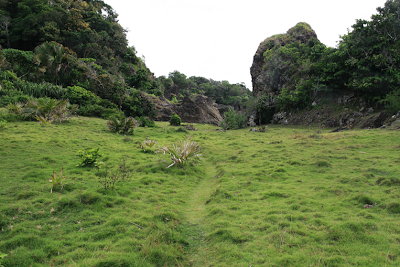Ever venture into
the western part of Java Island, Indonesia? Well, in this place, located a
national park called Ujung Kulon National Park, which is covering an area of 1.206 km2, which is the first
national park was inaugurated in Indonesia. This national park consists of
Krakatau island cluster and the small islands around it, such as handeuleum
island and Peucang island. This national territory consists of its 443 km2 of
marine area, which starts from The Cape of Ujung Kulon to the Indian Ocean.
 National Park The
Park is representative of the tropical rain forest ecosystem which is the
largest lowland in West Java. In addition to special habitat for the rhino, the
park is also used as a marine aquatic ecosystems, coastal and terrestrial
ecosystems. In this place, there are at least 35 species of mammals, 5 species
of primates, 59 species of reptiles, 22 species of amphibians, 240 species of
birds, 72 species of insects, 142 species of fish and 33 species of coral. There
are approximately 700 species of plants are protected in this place, and 57
types of which are rare plants such as Bengang ( Lagerstroemiaspeciosa ) and Luminous ( Pterospermum Diversifolium ).
National Park The
Park is representative of the tropical rain forest ecosystem which is the
largest lowland in West Java. In addition to special habitat for the rhino, the
park is also used as a marine aquatic ecosystems, coastal and terrestrial
ecosystems. In this place, there are at least 35 species of mammals, 5 species
of primates, 59 species of reptiles, 22 species of amphibians, 240 species of
birds, 72 species of insects, 142 species of fish and 33 species of coral. There
are approximately 700 species of plants are protected in this place, and 57
types of which are rare plants such as Bengang ( Lagerstroemiaspeciosa ) and Luminous ( Pterospermum Diversifolium ).
In 1992, Ujung Kulon National Park was inaugurated by UNESCO as a World Heritage site that is
protected. At the beginning of this region is an agricultural area. But when
Krakatoa erupted on August 27, 1883, this area was devastated and turned back
into forest. National Park which has beautiful natural scenery is now a
conservation center to protect the Java Rhinoceros which the number is getting less.
Currently at least 50 rhinos are in this conservation center.
*
Classification of Ujung Kulon National Park as a UNESCO World Heritage Site
Country : Indonesia
Category : Nature
Criteria :
VII, IX
Region : Asia Pacific
Official
Inscription : 1991
 National Park The
Park is representative of the tropical rain forest ecosystem which is the
largest lowland in West Java. In addition to special habitat for the rhino, the
park is also used as a marine aquatic ecosystems, coastal and terrestrial
ecosystems. In this place, there are at least 35 species of mammals, 5 species
of primates, 59 species of reptiles, 22 species of amphibians, 240 species of
birds, 72 species of insects, 142 species of fish and 33 species of coral. There
are approximately 700 species of plants are protected in this place, and 57
types of which are rare plants such as Bengang ( Lagerstroemiaspeciosa ) and Luminous ( Pterospermum Diversifolium ).
National Park The
Park is representative of the tropical rain forest ecosystem which is the
largest lowland in West Java. In addition to special habitat for the rhino, the
park is also used as a marine aquatic ecosystems, coastal and terrestrial
ecosystems. In this place, there are at least 35 species of mammals, 5 species
of primates, 59 species of reptiles, 22 species of amphibians, 240 species of
birds, 72 species of insects, 142 species of fish and 33 species of coral. There
are approximately 700 species of plants are protected in this place, and 57
types of which are rare plants such as Bengang ( Lagerstroemiaspeciosa ) and Luminous ( Pterospermum Diversifolium ).
In addition to
nature conservation center, Ujung Kulon National Park also offers many other
attractions. You not only spoiled by a variety of rare animals, but also can
enjoy a river with rapids sharp, waterfalls, white sand beaches, hot springs,
marine parks and cultural heritage and history are unique and interesting, such
as Ganesha statue on Mount Mercury, Panaitan Island.
*
Address Ujung Kulon National Park
Jl. No Independence
Pioneers. 51, Labuan, Pandeglang 42 264 West Java - Indonesia
Tel. +62 253
801731, Fax. +62 253 804651
Email:
btnuk@cilegon.wasantara.net.id




